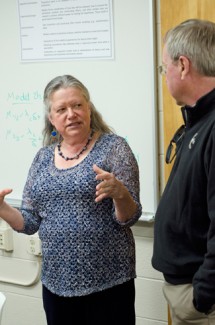NIH grant funds integrated research Collaboratorium
The University of Idaho was awarded a $10.6 million grant from the National Institutes of Health (NIH) to support the university’s new Center for Modeling Complex Interactions, which uses collaborative modeling to explore research questions of high relevance.

Nathan Romans | Argonaut
Department of Biological Sciences Professor Holly Wichman talks after the National Institutes of Health grant announcement in the Mines building.
According to Paul Joyce, dean of the College of Science, the grant will largely benefit the Collaboratorium for Modeling Complex Problems, the latest installment of the center.
Holly Wichman, distinguished professor of biological sciences, said the new grant is as a positive sign for the university’s future in research.
“This is really the formal beginning of something very exciting,” Wichman said. “I say it’s only the formal beginning because it builds on something that’s been brewing at the university for a long time.”
The announcement was made Wednesday night in the Mines Building, where the center is located. Joyce and Wichman were joined by UI President Chuck Staben to make the announcement and address the future of the center.
The grant is a part of a larger program, the Institutional Development Award (IDeA) which funds both the Idea Network for Biomedical Research and Excellence (INBRE) and the Center for Biomedical Research Excellence (COBRE).
“UI has a lot of influence in setting policy for the National Institutes of Health because of all of our programs,” Joyce said. “In addition to the $10.6 million for COBRE, the university has received $17.4 million for INBRE, which makes a total of $27 million in NIH funding over the last eight months.”
Joyce said the Mines Building houses one of the most integral research installments at the university.
“The Mines Building was built in the early ‘60s on the side of a hill like a mine shaft with all of its windows on one side … It’s not a pleasant building,” he said. “Luckily, we didn’t have much funding at the time or we would have ended up with more buildings like this one.”
Despite his jests about the structure, Joyce said the building holds great significance because of the extensive renovations it has undergone.
Joyce said this particular COBRE grant supports three research projects that operate in the center and focus on viral infection.
Wichman said the Collaboratorium is not only a big step for biomedical research, but it also promotes interdisciplinary and collaborative research methods.

Nathan Romans | Argonaut
Dean of the College of Science Paul Joyce, left, Chief Communications and Legislative Affairs Officer of the Idaho State Board of Education Blake Youde, center, and University of Idaho President Chuck Staben speak with each other after the conclusion of the National Institutes of Health grant announcement in the Mines building.
“We have some wicked problems to solve,” she said. “These problems won’t be solved by one woman sitting at a computer by herself or one man working at a lab bench alone … We’re going to solve these problems by working together as teams of people who bring different skills to the table.”
Wichman said the new Collaboratorium is a place where laboratory scientists and modelers would communicate with one another in a common language — the language of modeling, statistics, mathematics and visualization.
“We’re not going to train lab scientists to do math and we’re not going to train modelers to do viral growth,” she said. “We’re going to expose lab scientists to modeling and this will change the way they think about their research.”
Wichman said the benefit of integrated and collaborative research is that researchers will be able to learn from each other’s respective strengths and weaknesses.
“We anticipate that through collaboration we will build a kind of synergy,” she said. “Researchers of all flavors will get different ideas about how to adapt their skills and how to test underlying assumptions and minimize errors … We anticipate that all of this will lead to innovation.”
Corrin Bond can be reached at [email protected]
